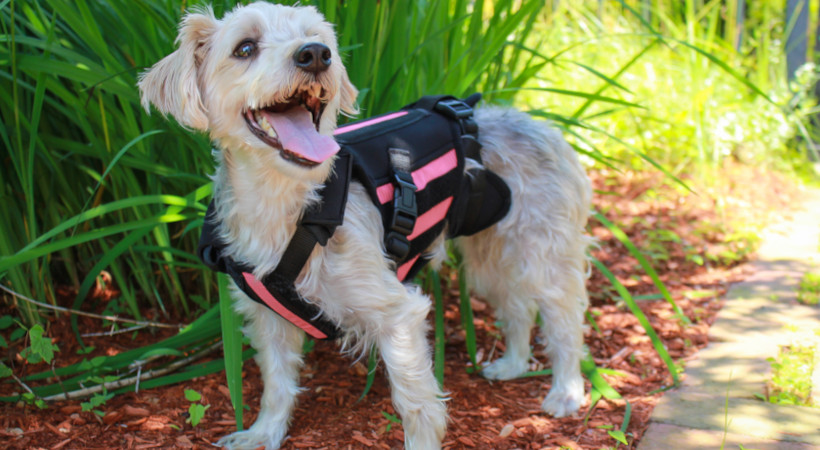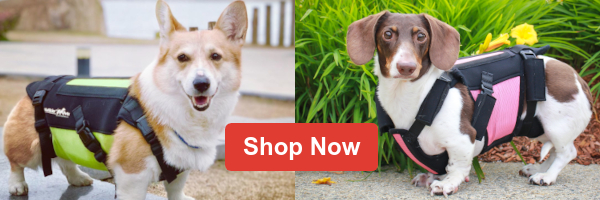- July 31, 2023
How to Avoid Back Problems in Dogs

Dogs, like humans, can experience back pain due to factors such as age, injury, or illness. This condition can cause discomfort and hinder their mobility. However, there’s no need to worry. By staying vigilant and taking precautionary measures, there are changes you can make to improve your dog’s back health and improve their overall well-being.
How do I know if my dog has back pain?
Dogs have an instinct to hide their pain if they can, and unlike us, their pain threshold is high. So, it’s not always so easy to see that your dog has a problem. However, there are a few tell-tale signs that may indicate that your dog has back pain.
- Muscle tremors or shaking
- An arched back
- Difficulty bending over to eat or drink.
- Difficulty defecating
- Refusal to walk around, play, or jump.
- Reluctance to be held or picked up.
- Whimpers or cries of pain.
When a dog is experiencing pain, they also tend to exhibit changes in its behavior or the way they move. If your dog is showing any signs of back pain or a concerning behavioral change, it’s time to visit the vet.
Which dogs are affected?
Back issues and back pain most often affect middle-aged and older dogs. However, any dog can experience back issues, whether it’s in genetics, age, or injury. There are certain dog breeds that are more susceptible to this problem than others. Specifically, breeds with a long back, such as dachshunds, corgis, or basset hounds, are most affected by back pain.
What precautions should be taken against back problems?
Monitor Your Dog’s Weight
To avoid back pain, watch your pet’s diet. Being overweight places strain on a dog’s joint and even increases their chances of having back problems. For dogs genetically predisposed to disc herniations, ruptures, and other spinal issues, do your best not to overfeed your dog, exercise them regularly, and work to keep them at their optimal weight.
Regular Exercise
Keeping your furry companion in good shape is important and regular exercise can help your pet stay healthy. Swimming is another great activity that is a great workout without placing too much strain on a dog’s body.
Avoid strenuous exercises, such as agility, jumping, and running if your dog has a bad back. These may aggravate your dog’s back pain or place too much strain on the spine. Not sure what exercise is best for your dog? Speak with a canine rehab specialist, they can work with you and your dog to develop an exercise plan to keep their back healthy and strong.
Back Support
A back brace, like the Walkin’ vertebraVe can support your dog’s spine, lessen back pain, and limit range of motion. Particularly recommended following an injury, or disc issue a back brace provides good support for a dog’s entire back. The memory foam layers of the back brace conform to your dog’s spine to support from the cervical spine down to the lumbar spine. As your pet heals, the metal support spines can be removed to open up the dog’s range of motion and lessen the support.
Start Your Dog on a Daily Joint Supplement
Introduce a daily joint supplement to your pet as soon as possible to promote joint health and keep your dog active. Choose a supplement with a scientifically proven formular that combines high-quality ingredients like Green Lipped Mussel, Hyaluronic Acid, Glucosamine, and Chondroitin to help maintain joint mobility.

Related Articles:
Tags
What do you think?
Related Articles

New Puppy Checklist: Gear You’ll Need for Your New Dog
Getting a new puppy is really exciting, but before you welcome them home, it’s important to prepare your space for them. Since puppies need a

How Big Do Mini Poodles Get? Vet Reviewed Average Weight & Growth Chart – Dogster
The information is current and up-to-date in accordance with the latest veterinarian research. Learn more » When you buy a Miniature Poodle, you might not

Can Police Dogs Smell Nicotine? Vet Verified Facts & Info – Dogster
The information is current and up-to-date in accordance with the latest veterinarian research. Learn more » While cigarette sales have been declining steadily for decades,

How Old Is 5 in Dog Years? Vet-Approved Guide to Each Size of Dog – Dogster
The information is current and up-to-date in accordance with the latest veterinarian research. Learn more » A common method for calculating a dog’s age is

